Travellers have been coming to the Galápagos since the early 16th century. Charles Darwin arrived in 1835 and made the volcanic archipelago famous for its wild denizens, which, in the 20th and 21st centuries, Sir David Attenborough turned into television stars.
But there’s been a colourful parade of explorers, pirates, buccaneers, whalers, sealers, speculators and colonists who have also weighed anchor here since the first documented arrival by Fray Tomás de Berlanga. He stumbled upon the islands while sailing from Panama to Peru in 1535, ending their long isolation and heralding the start of their exploitation. It’s likely that Indigenous sailors from the South American continent visited before Berlanga, but unlike many Pacific islands, the Galápagos wasn’t colonised until modern times. By then, thanks to Darwin and forward-thinking Ecuadorian administrators, the archipelago’s unique scientific value had been recognised.
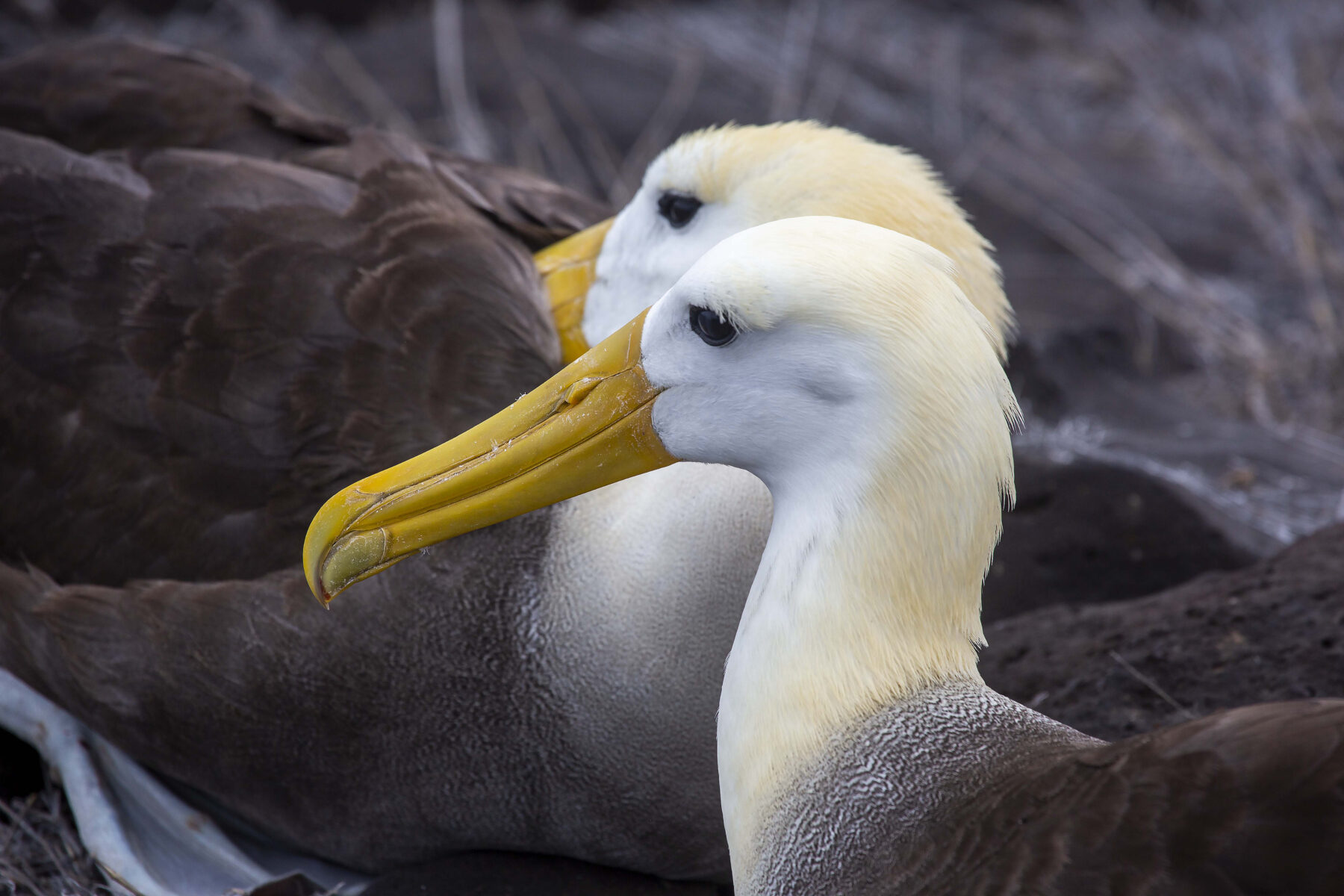
Another notable visitor was Herman Melville, who arrived as a young seaman in 1841 aboard the whaler Acushnet. Melville’s hard life aboard Acushnet informed his classic novel Moby Dick, with its vengeful white whale and crazed Captain Ahab. The famed piece of literature was inspired by the true story of the whaler Essex, which was rammed and sunk by a whale while the ship was conducting its bloody business in 1820. The Essex’s crew had harvested almost all the giant tortoises as a ready source of fresh meat from Floreana in the Galápagos. They set fire to the island as they departed, destroying the remaining animals and sending the Floreana tortoise species extinct. The grim fate of the Essex and its crew was regarded by certain superstitious old salts as a form of natural justice for the demise of the tortoises and the ravaging of sperm-whale populations by 19th-century whalers. What’s certainly true is that Melville later penned a series of magazine stories called The Encantadas, or The Enchanted Isles, that recalled in vivid detail the strange worlds and even stranger creatures he encountered while in the Galápagos.
Today, it’s our turn to be enchanted by this unique archipelago, deservedly regarded as nature’s living laboratory.

This Australian Geographic Society expedition, in partnership with Hurtigruten Expeditions, has brought a band of modern explorers to the Galápagos. I’m here with an enthusiastic group of Australian Geographic readers, all filled with anticipation, and excited to board MS Santa Cruz II. It’s been a protracted journey over several days to reach the Galápagos. Such isolation has shaped the destiny of this nature-lover’s paradise and continues to help protect it today.
It’s early September – traditionally low season here. And with COVID still casting a long shadow across international travel, we’re a tight group of just 26 voyagers aboard an expedition ship equipped to accommodate many more. We begin as strangers. But during the next week of shared natural encounters, adventures in and out of the water, meals and lectures together aboard Santa Cruz II, we’ll coalesce into a band of comrades, learning and growing together in a shared spirit of enthusiasm…with plenty of laughs along the way. We’ll spend days exploring the south-easternmost islands of the archipelago from our floating base, surrounded by its Scandinavian-inspired decor and led by its team of expert Ecuadorian naturalists. Their knowledge, passion and humour will convert us all into ambassadors for the Galápagos.
The islands we’re visiting are the oldest in the group and are volcanically inactive. This is in contrast to the westernmost islands of Isabela and Fernandina, which have many active shield volcanoes that continue to belch fumaroles of scalding, sulfuric steam and dispatch rivers of boiling lava down to cool and solidify in the sea in a cycle of island building. The most recent eruptions were Wolf Volcano on Isabela, in January 2022; La Cumbre Volcano on Fernandina, in 2020, 2018 and 2017; and Sierra Negra Volcano on Isabela in 2018.
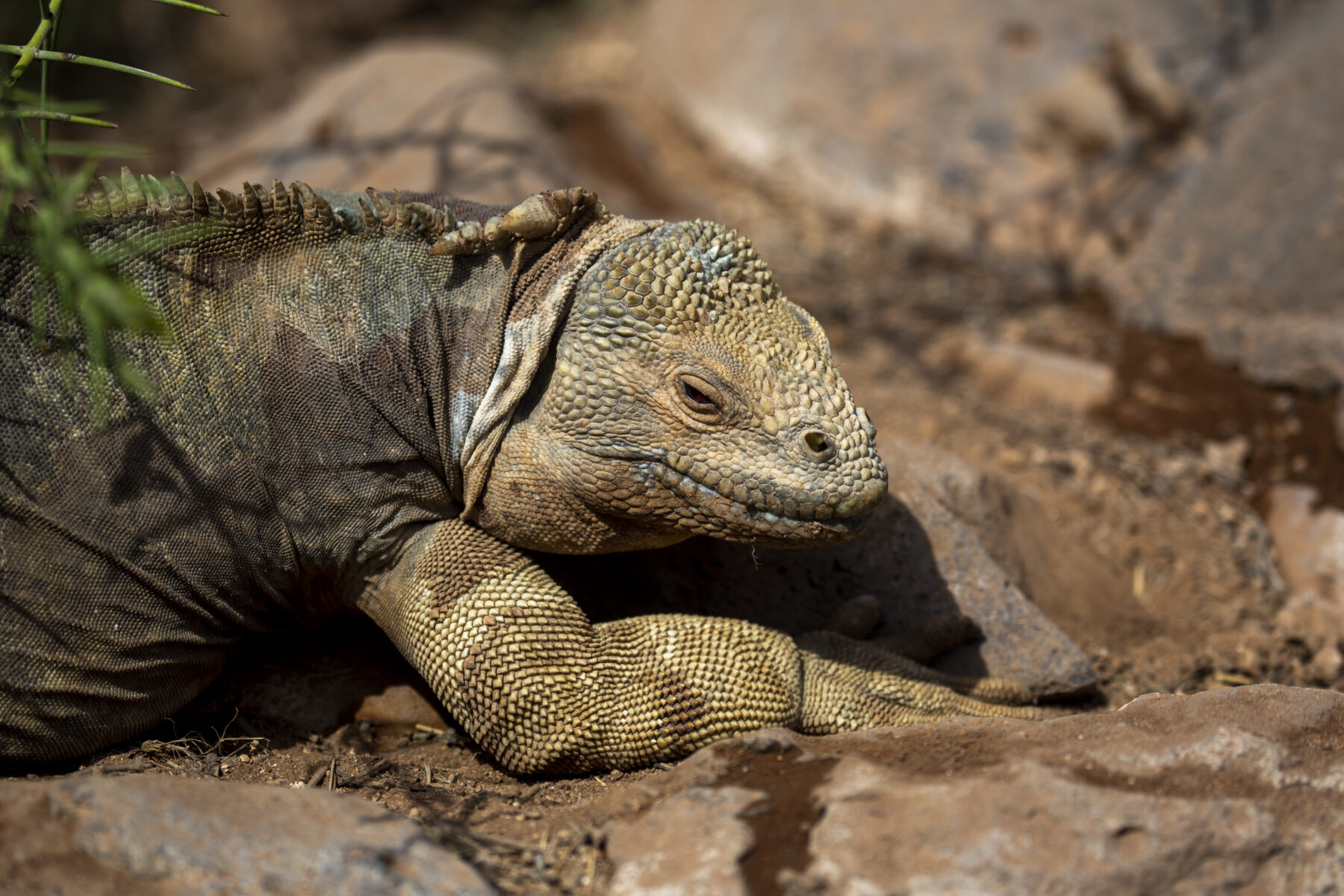
The Galápagos is an island chain formed abovea volcanic hotspot, where magma from deep within the planet’s mantle wells up and creates volcanic activity. Magma that causes a hotspot is much hotter and more fluid than that which forms at a tectonic plate boundary, so it’s able to punch through Earth’s crust and forge a volcano on the surface. The hotspot is still active and new islands occasionally appear after volcanic eruptions, but as the Nazca Plate on which the islands lie continues drifting south-eastwards, the older islands move further away. Time has done the rest, transforming these old volcanoes into flatter, more productive ecosystems that support not just high levels of flora and fauna biodiversity, but a few human settlements, agriculture, a world-leading conservation program and a burgeoning tourism industry.
Mosquera and San Cristóbal
We arrive by inflatable craft on Mosquera, a narrow shard of rock, on our first sunny afternoon and enjoy the first of many interactions with Galápagos sea lions. Their golden fur turns dark and glossy in the surf, where they frolic and toss hapless fish around, seemingly for fun. They’re mostly oblivious to us but are occasionally inquisitive, and we get our first taste of the fearlessness of Galápagos wildlife.
Hard to miss among the black basalt boulders are the bright red, blue and yellow carapaces of Sally Lightfoot crabs. Named by early sailors for a famous ballerina, these stunning crustaceans can move in a dance-like manner in every direction, unlike the more limited sideways movements of most crab species.
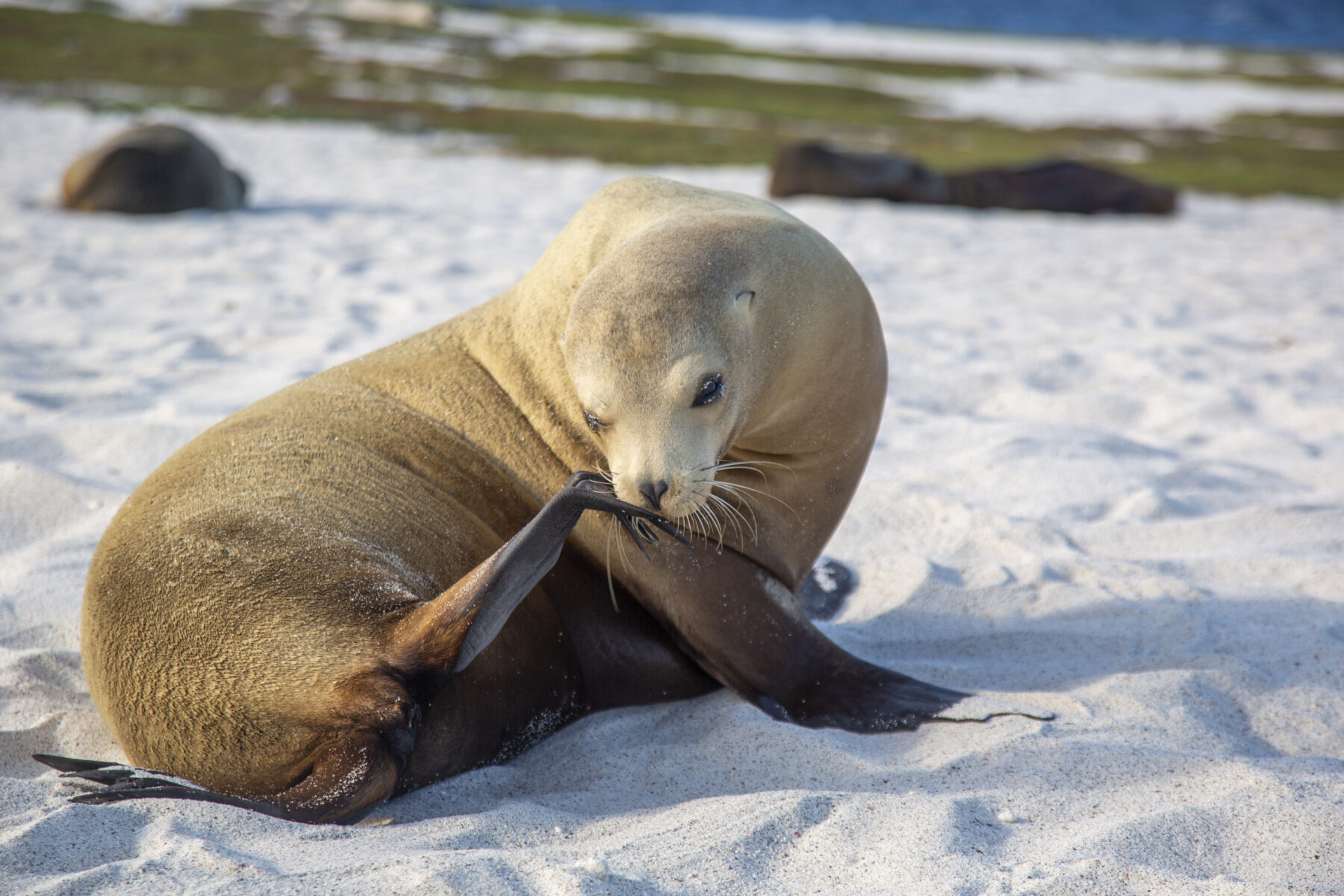
Overnight, we travel to the Galápagos’s most easterly island, San Cristóbal, and land at Punta Pitt just after dawn. Its ochre-hued volcanic tuff moonscape divulges ancient origins, but today it’s a haven for a variety of seabirds and it’s here we meet our first boobies. There are three varieties – the more abundant blue-footed species, the harder-to-spot red-foots that nest here among stunted sparse vegetation and the Nazca booby. The blue-footed chicks don’t flinch as our procession of camera-wielding admirers passes close to nests beside the designated track, from which we’re told not to veer.
It’s not always easy to stick to the rules or maintain the prescribed 2m buffer when birds stubbornly take up positions in the middle of tracks. But these moments provide unobstructed views of their superb webbed blue feet and allow us to marvel at a hue rarely deployed in nature, but here gifted to this endearing, comical bird for the purposes of impressing a mate. We spot endemic San Cristóbal mockingbirds as they dart out from between rocks and bushes; they flit fearlessly around our feet as we clamber up through the rugged tuff cliffs. It seems these charismatic birds are as curious about us as we are about them.
September brings the season known as Garúa. Cool upwellings from the vast depths of the Pacific Ocean combine with cold currents flowing northwards up the South American coast to create a mild year-round climate, despite the Galápagos’s geographic position along the Equator. Garúa, meaning drizzle, is the coolest season and is characterised by cloud cover, winds and light rain in the mornings. It’s good walking weather and, with lower tourist numbers, the perfect time of year to visit.

We reach the high cliffs of San Cristóbal just as the early-morning sun pierces the low-hanging cloud layer. It shoots rays down through a cleft to burnish the ocean’s surface and our uphill effort is rewarded with a shimmering dance of light on the water. We visit the island’s human settlement of Puerto Baquerizo Moreno in the afternoon and enjoy our first encounter with Galápagos’s most famous denizen, the giant tortoise, at the Cerro Colorado “David Rodriguez” Breeding Center.
This global conservation emblem that gives the Galápagos its (Spanish) name, is undoubtedly one of the planet’s most incredible creatures. “Lonesome George”, the solo survivor of the Pinta Island species of giant tortoise (Chelonoidis abingdonii), and once regarded as the rarest creature in the world, became an icon. He was famously filmed by Sir David Attenborough in 2012 in an emotional sequence made even more so by the century-old reptile’s death just days after David’s encounter. Inscribed on his enclosure on Santa Cruz Island were the words, “Whatever happens to this single animal, let him always remind us that the fate of all living things on Earth is in human hands.”
Pinta Island’s position along a key shipping route led to the over-exploitation of its tortoise population by early whalers, sealers and other fortune seekers, as happened elsewhere in the islands. Giant tortoises could survive months without food or water in ships’ holds. At least 100,000 individuals were likely removed across the archipelago before controls were introduced in the 1950s. The Pinta is one of five Galápagos giant tortoise species that have gone extinct, leaving 15 that are today the subject of intensive and effective conservation. In a stunning comeback for these gentle giants, an estimated 20,000 individuals across numerous species now live within the breeding centres and nature reserves of the Galápagos National Park.
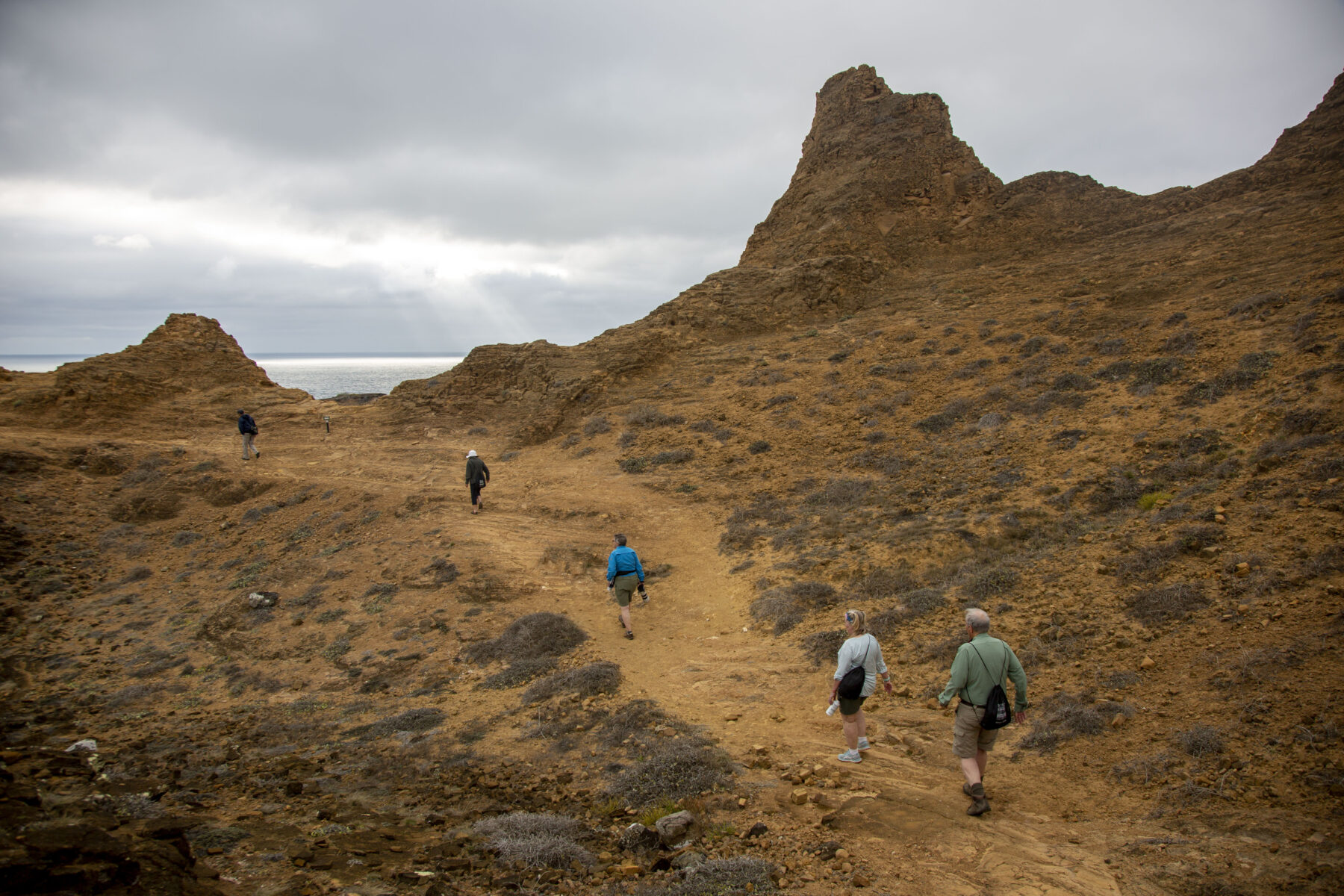
Santa Fé and South Plaza
Our next port of call is Santa Fé Island, a small speck with a big assemblage of endemic creatures that are not even found elsewhere within the archipelago. Some visitors to the Galápagos like to tick off the Big 15, much like Africa’s Big Five. Between Santa Fé and South Plaza today, and Española later in the week, we’ll get most of the list populated.
On our way to a beach landing on Santa Fé, a pod of humpback whales passes within metres of our little flotilla of inflatable vessels, and suddenly an exhilarating chase is underway. Our Ecuadorian naturalists follow the pod out to sea for a few kilometres, but we are well and truly outrun and turn back towards the island having revelled in the thrill of an unexpected wildlife moment.

Santa Fé is among the oldest islands here and one of few that didn’t begin life as a volcano. Its great age has endowed it with high levels of endemic species, including Galápagos mockingbirds, rice rats, Santa Fé land iguanas, snakes and Galápagos hawks. Most immediately striking is the large sea-lion colony on the beach in Barrington Bay, where females sunbake while their pups play in the water. Large males belch and grunt, facing off with each other as they guard harems. We’re relieved our presence goes largely ignored by them as we file past after disembarking for our guided walk. We climb up from the beach and pass a solitary stocky Santa Fé land iguana basking on the warm rocks. We’re dwarfed by sculptural prickly pear cactus trees (Opuntia spp.) that grow in abundance here.
We return to Barrington Bay later for a drift-snorkel among its clear waters. In the choppy, cool sea we float and freedive among fish too numerous to identify. Green turtles occasionally surface for air and it’s just possible to discern the tell-tale outlines of reef sharks in the depths below. Mischievous young sea lions join in the fun as we drift back towards their beach, and they cause a few hearts to flutter when they cheekily pop up right next to unwary swimmers.
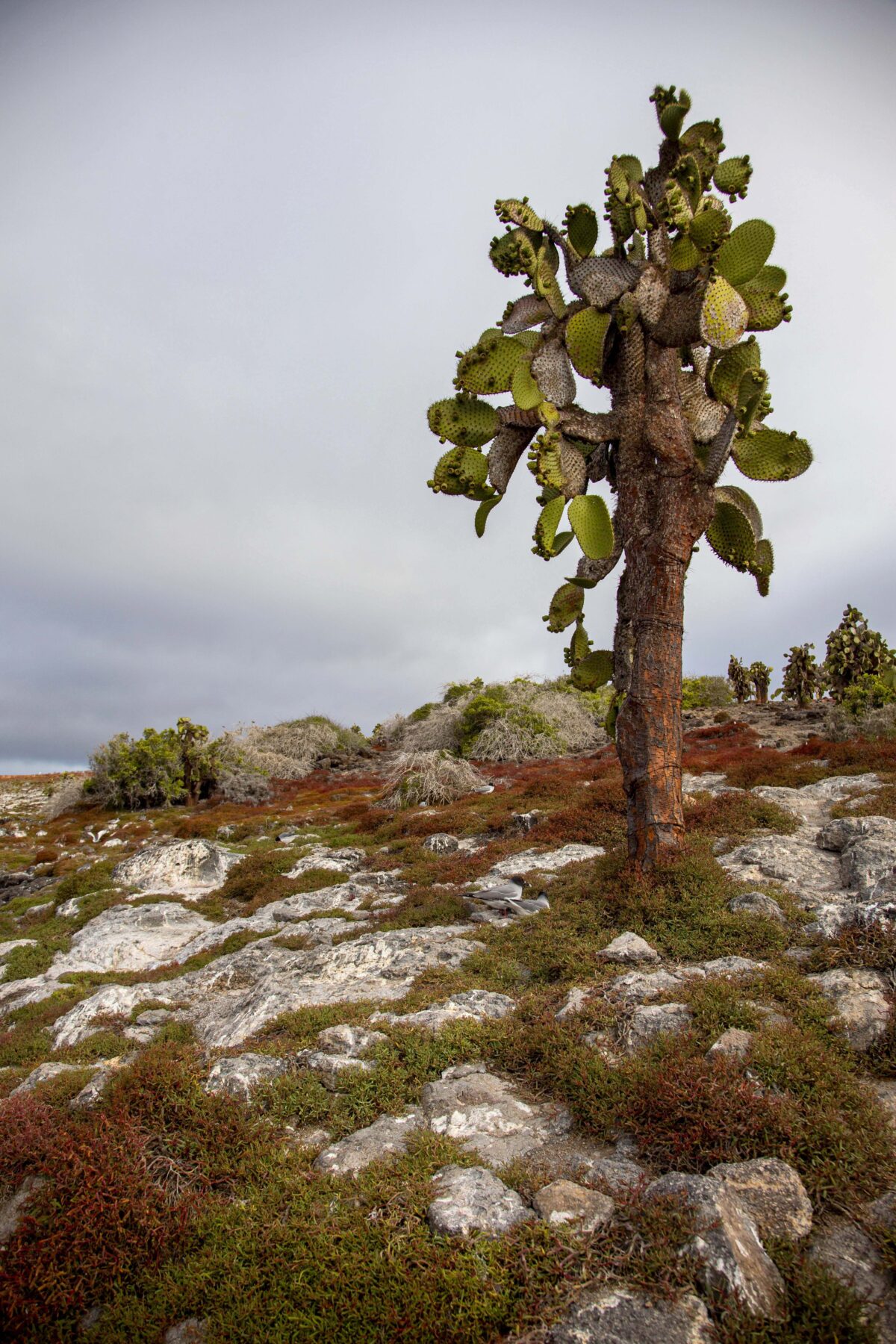
Santa Cruz II heads towards its namesake island, which is tomorrow’s destination. Before that we explore South Plaza, lying just off its eastern shore. Eye-popping bright-red sesuvium carpets the stony terrain from which rise more of those striking cactuses, creating a superb multicoloured vista across the island. Wheeling around its high cliffs are brown pelicans, boobies of all kinds, and our first close sightings of marauding magnificent frigatebirds with their bright crimson neck pouches. These avian thieves are always ready to snatch a fishy morsel or twig of nesting material from the beaks of gullible birds.
Elegant red-tailed tropicbirds rapidly twirl and nosedive, posing no end of focusing challenges for the photographers among us; as for the twitchers, it’s hard to know in which direction to point the binoculars, such is the abundance of bird action.
We catch sight of our first marine iguanas high on the cliffs. They’re easy to miss with their matt black bodies camouflaged against the basalt rocks, and their frozen poses. On each island we’ll visit during the coming days we’ll encounter even greater gatherings of these intriguing reptiles, the world’s only marine lizard species, as well as their bulkier and more solitary cousins, the land iguanas.
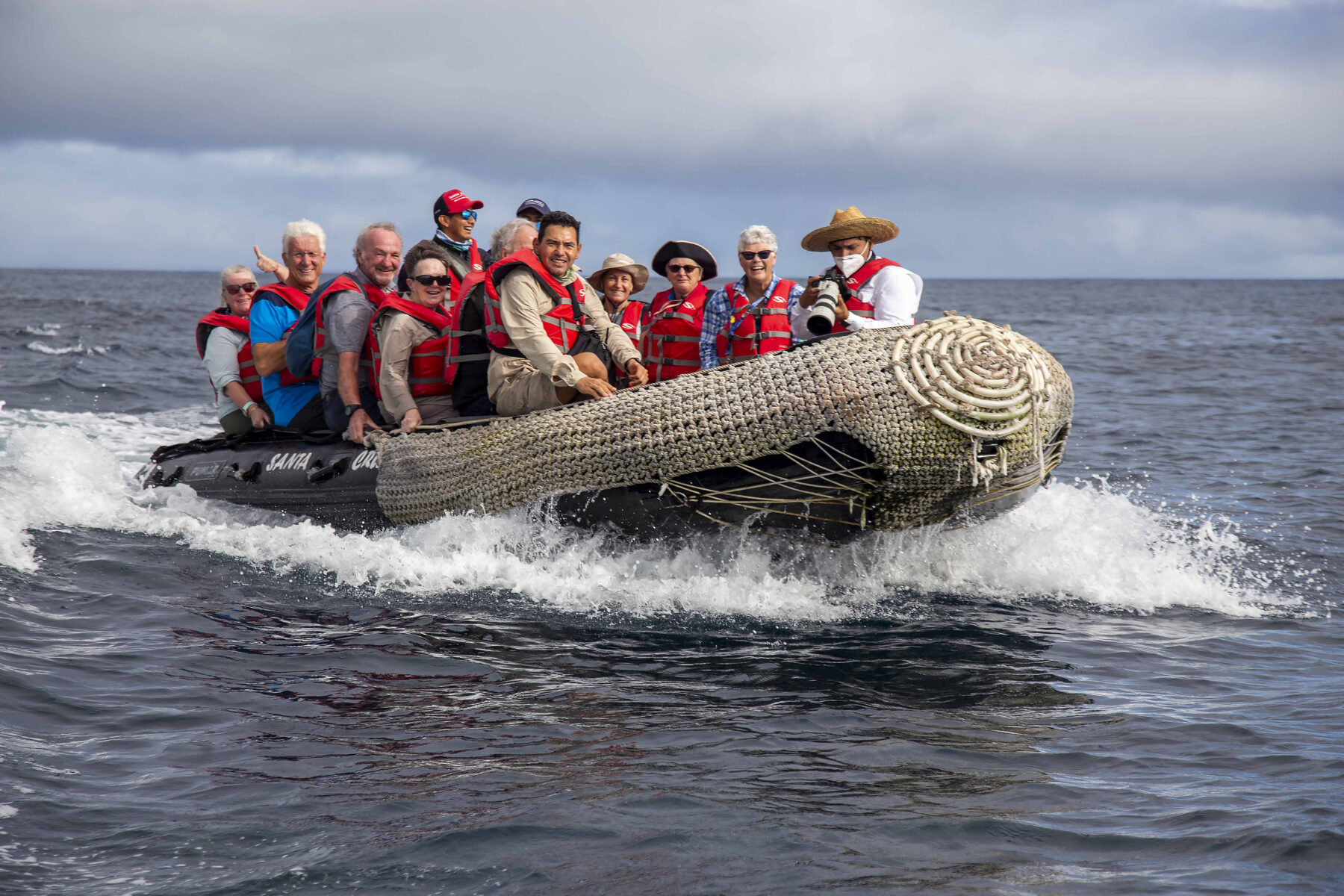
Santa Cruz
Darwin’s era-defining sojourn among these islands lasted a mere five weeks in 1835, but it was to have a profound effect on our understanding of all life on Earth, and our place in it. He collected specimens, including finches and mockingbirds, and kept copious field notes that he later used to crystallise his theory of evolution. As his ship HMS Beagle moved between islands, Darwin observed how members of the same species developed different physical adaptations to suit localised environments, especially among the finch and mockingbird species, and he published his findings in On the Origin of Species in 1859.
Darwin’s work brought the Galápagos to the attention of the world and played a vital role in the subsequent protection of the islands. In 1935 the Ecuadorian government enacted the first protective legislation for the islands. In 1959 the Charles Darwin Foundation, which operates the Charles Darwin Research Station, was founded to support scientific research and conservation efforts in the Galápagos. That same year, 98 per cent of the archipelago was gazetted as national park, and in 1978 it was declared a UNESCO World Heritage Site.
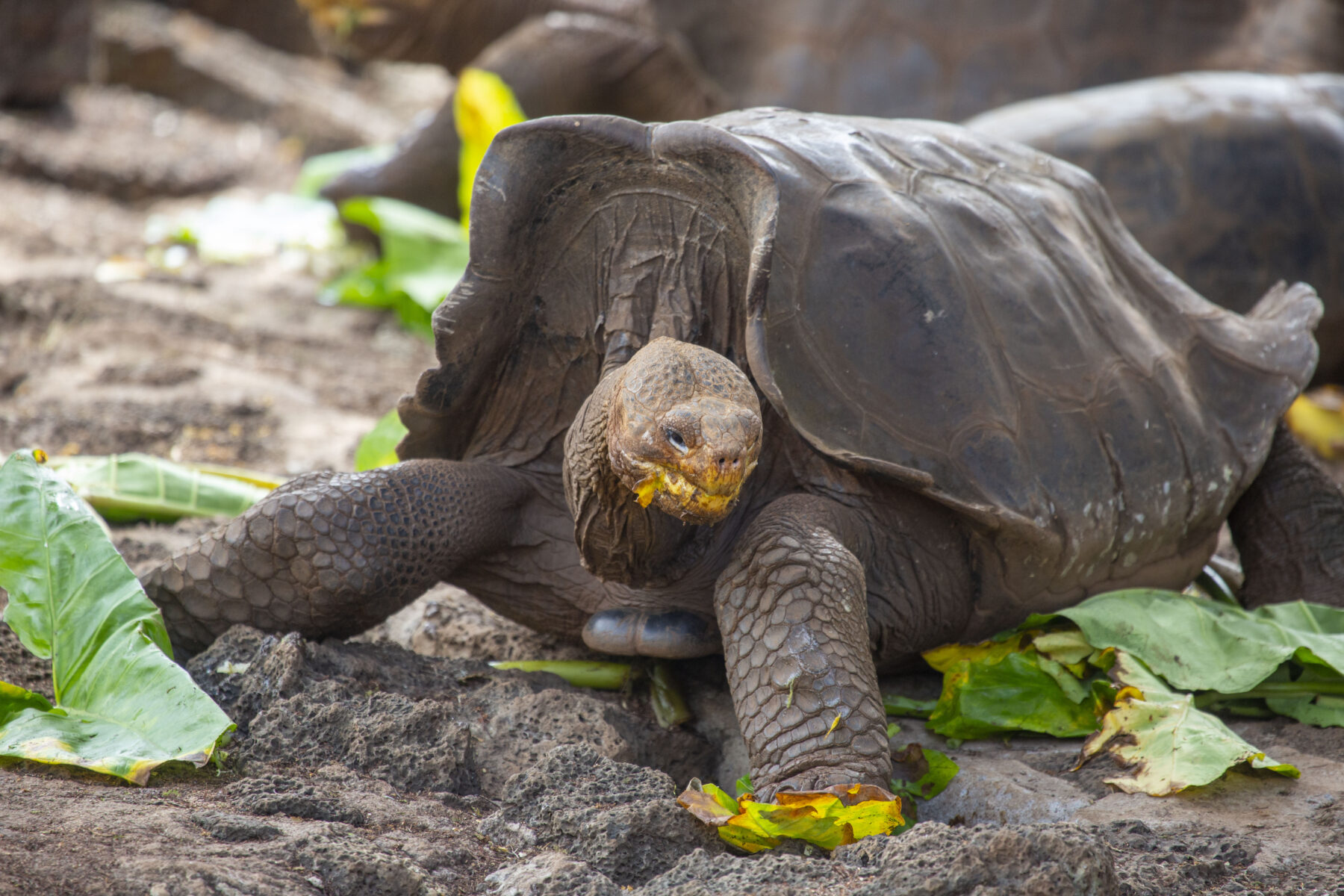
According to Esteban Kolb, our expedition leader, there’s a fragile balance here between the need to preserve and rehabilitate these unique natural ecosystems and the growing demands of tourism to support the local economy. “The national park and its rules are doing a pretty good job. They’re controlling in every direction you can imagine. But I still believe there has to be a stronger collaboration between the national park and the companies that are, one way or another, operating in the Galápagos,” Esteban says. “But so far, due to the amazing and tough job they have done over the last 70 years, the Galápagos is able to offer incredible diversity in a very pristine way without making it look like an amusement park or something that’s not real. It is really authentic and that’s the beauty of it.”
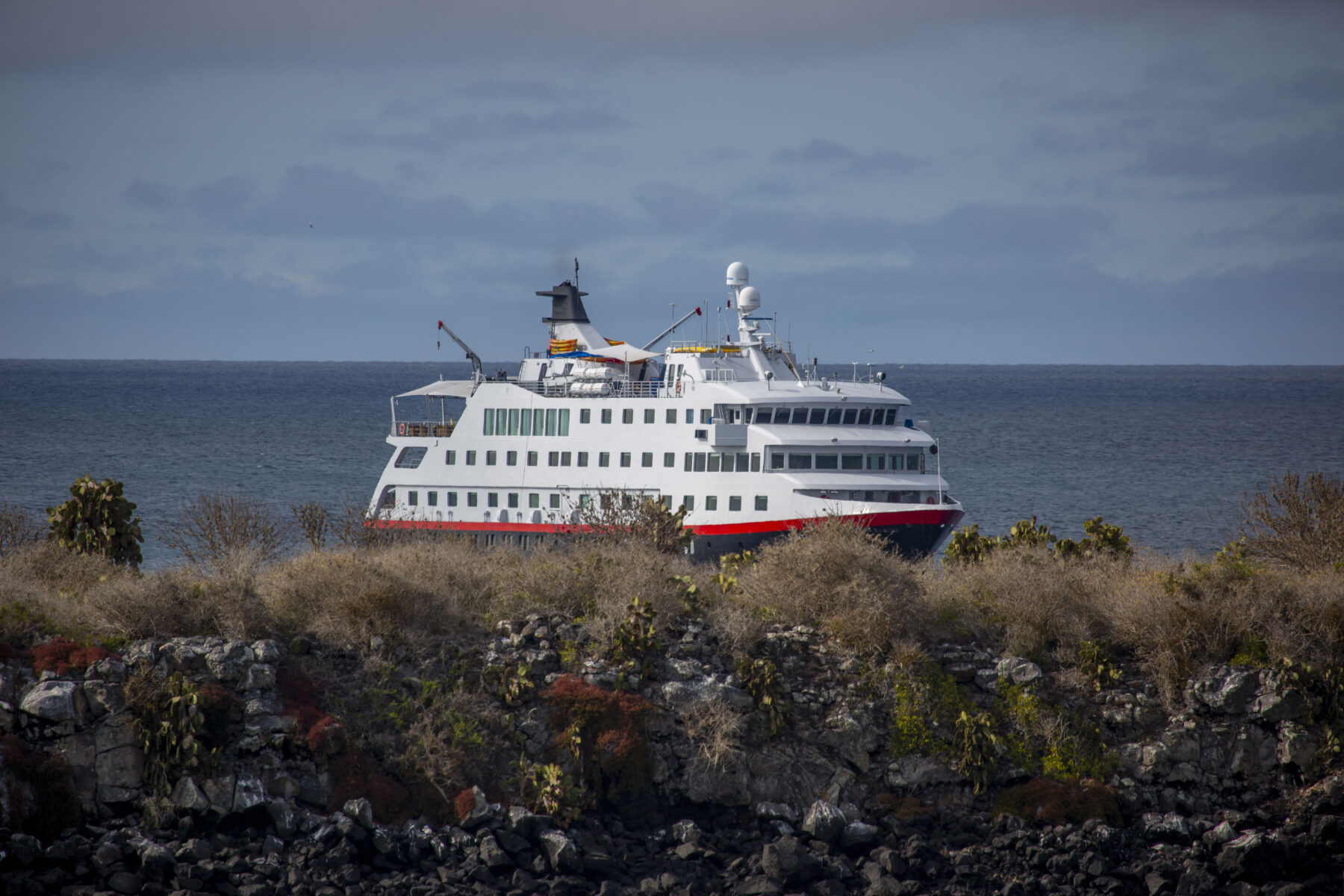
We learn more about the natural history of the Galápagos, its conservation challenges and successes and see more giant tortoises as we explore the Charles Darwin Research Station in Puerto Ayora, on Santa Cruz, the most populous and developed of all the islands.
There’s a bike-riding opportunity, and in the afternoon we visit a grassy reserve up in the central highlands where wild tortoises roam – grazing, mating, fighting and wallowing, like big shiny boulders, in gloriously muddy pools. Visitors can roam freely among them – a close encounter to be treasured.
Nearby, we descend into a old lava tube, dark and damp, disturbing a resident barn owl that swoops down for a closer look. The tube offers a fascinating glimpse into the geological genesis of these islands.
Then it’s back to town for some must-do tourist shopping. In this buzzing town of 18,000 people, there’s also an opportunity to enjoy a beer or two among the local Galapagueños before heading back to Santa Cruz II.
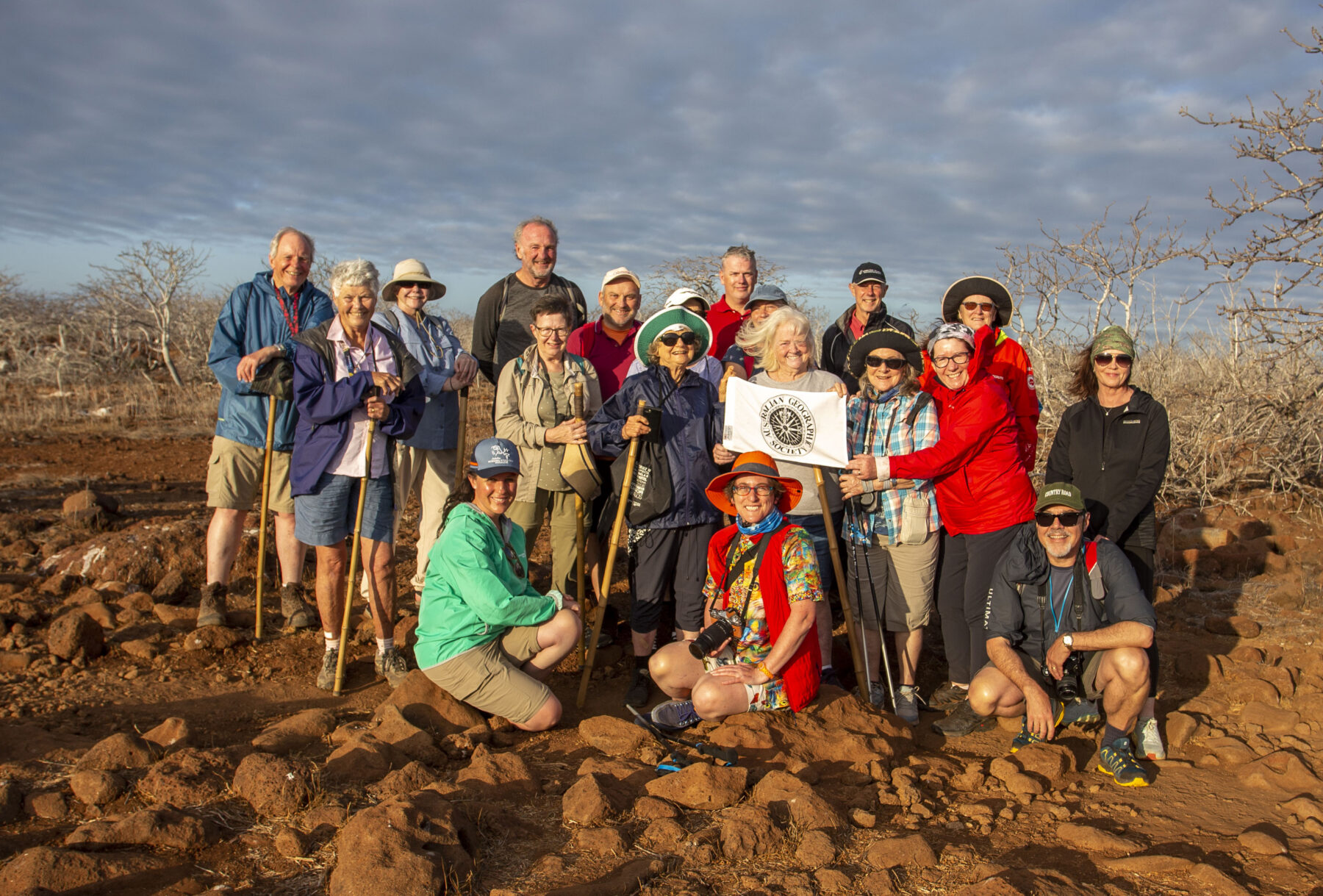
Each night we enjoy what’s known as an “eco moment” before dinner. These illustrated talks by our Ecuadorian naturalists are a chance to prepare for the following day’s sights, armed with knowledge that makes every encounter meaningful. The Galápagos is a destination for energetic, active and curious souls, and our group is united by a strong desire to learn.
Brendan Murphy, from Sydney, enjoys the fast pace of the tour. “The days are jam-packed. Every day you see something new. And I think it’s amazing, too, that within a really small area, the islands can each be so different,” he says. “One island feels like you could be in the middle of an Arizona desert, and the next is more like a tropical rainforest. It’s remarkable how close they are to each other and yet they are so different.”
Brendan’s ecologist wife, Amanda, is impressed at the way the national park is actively managed for conservation, and how tourism is tightly controlled. “It’s not just lip service here as in ‘here’s a national park and now we’ll just let it go’,” she says. “Sure, they could bring big cruise ships in here left, right and centre, because it’s on everyone’s bucket list to go and see the Galápagos. But they’re limiting tourism and they’re not putting economics ahead of the priceless value of the environment.”
EspaÑola
During coming days, we visit Española where we’re privileged to see rare waved albatross at close quarters. We gaze on in hushed reverence as they go about their protracted, stately courtship dances, complete with bowing, honking and fascinating bill-clacking rituals. They’re oblivious to our presence in their remote stronghold, where there’s an estimated 12,000 breeding pairs.
We boulder-hop carefully over the arid terrain (walking poles highly recommended) to avoid stepping on marine iguanas and little red-daubed lava lizards, so dense are reptile numbers here. Precipitous, wave-smashed cliffs at Punta Suarez offer perfect launch pads for albatrosses; they career awkwardly towards the precipice, disappearing momentarily over the edge, only to rise again to join an aerial throng of frigatebirds, gulls and tropicbirds in the mist-laden air.
There’s more deep-water snorkelling, as well as kayaking and stand-up paddleboarding opportunities in the swell, and we return cold and exhausted to the ship to warm up in the twin spa pools on the rear deck.

Edén and North Seymour
The sun illuminates our final day. On Edén Islet we’re treated to a glass bottomed–boat tour to see marine life while we stay dry. We finish the expedition on North Seymour, where frigatebirds nest on bare branches, and we get close to the action as males inflate their huge crimson throat sacs to impress potential mates. Blue-footed boobies guard nests perched precariously on the stony ground and the scales of portly land iguanas turn yellow-gold in the glowing late-afternoon light.
It’s time to farewell the Galápagos and we gather for a photo before reluctantly returning to the ship. Some of us linger as long as possible among sea-lion families on the shore, breathing in the pure, salty air before reluctantly climbing into the inflatables as the sun dives towards the horizon. This silent reverie is broken by the sudden gun of the motors, and off the little flotilla tears into the darkening distance, as nature heaves a sigh of relief – at least until tomorrow.
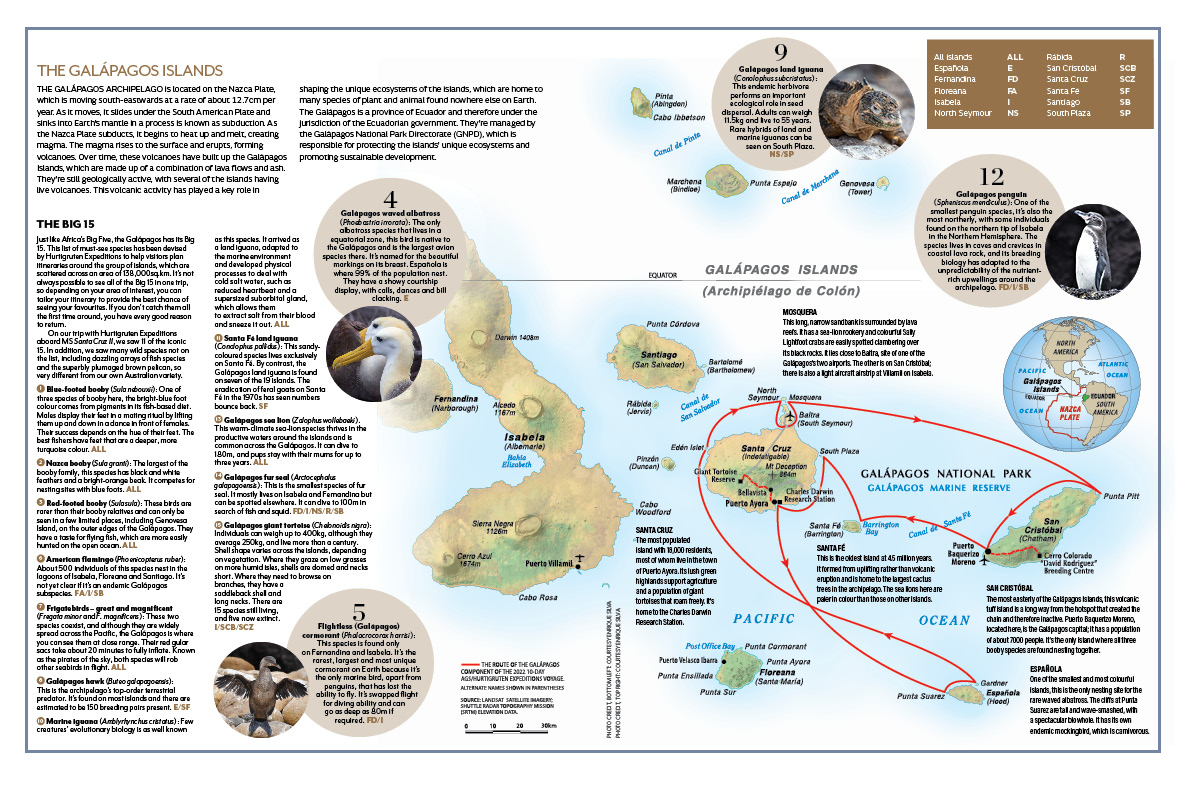
Australian Geographic thanks Hurtigruten, Esteban Kolb, Enrique Silva and all those mentioned and pictured in this story.



